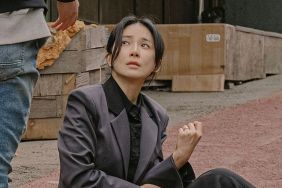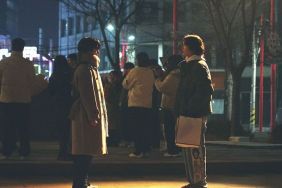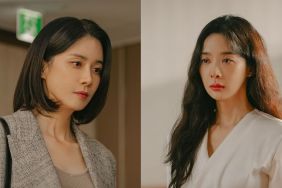Brutal revenge thriller from the man behind A Tale of Two Sisters

You can generally expect a Korean filmmaker to take a different approach to whatever genre they’re tackling, and with the unconventional ghost story A Tale of Two Sisters under his belt, director Kim Jee-woon takes a similarly unique approach in exploring the dark world of serial killers and the revenge thriller in his latest film I Saw the Devil.
As the film opens, a mysterious stranger played by Old Boy star Choi Min-sik brutally murders the pregnant fiancée of a special agent, played by Lee Byung-hung (G.I. Joe). The latter isn’t going to take that horrific crime lying down, but instead of letting the law take its course, he goes after the killer himself in order to dole out the type of violent revenge the murderer deserves, and so begins an exhausting chase through the city that leaves many bodies in their wake.
Anyone who enjoyed the stylish nature of Director Kim’s previous film, the cult Western The Good, The Bad, The Weird, will appreciate his cinematic approach to this dark subject matter, although I Saw the Devil is not for the squeamish or weak of stomach as he gleefully shows every graphic detail of the absolutely unspeakable horrors perpetrated by both the lead characters.
ShockTillYouDrop.com had a chance to sit down with Director Kim during his stopover in New York on the film’s extensive journey through the film festival circuit.
ShockTillYouDrop.com: You’ve written a lot of your previous movies though not this one, so what did you like about the script that made you want to direct it?
Jee-woon Kim: The script itself was a very strong, raw powerful script, and I thought it had a a few differences from revenge films that we might have seen in the past that I was keen on, like suddenly coming upon the serial killer in the middle of the movie instead of just catching him at the end and that being the end of the film. Instead, we see that in the middle of the film and we see action taking place from there with this process of portioning out that revenge through the course of the film; it’s not all just done in one shot. He draws out that process of revenge, and also, the serial killer mounting a counter-attack in a way to the cop character. These things were interesting to me and different from existing revenge films.
Shock: How long ago did you find the script?
Kim: There was a U.S. project that I was preparing to do that was unfortunately delayed for about a year or so, and I was looking for something that I could do in the meantime, and Choi Min-sik from “Old Boy,” who plays the serial killer role in this film brought the script to me, saying that he found a very powerful script and whether I would be interested in it. Like I said, I saw those points that were attractive about the script and that drew me to the project.

Shock: It’s interesting he was involved from the beginning because the role he plays has him doing a lot of really horrible things to his victims, so did you end up pushing him even further than what was in the original script?
Kim: Choi Min-Sik had taken a step back from film for about four or five years after his appearance in “Lady Vengeance” with Park Chan-wook, so this was kind of a comeback film for him and he brought it to me. Maybe in his mind he thought that he needed to do something very strong and powerful as a comeback to give a punch in a way to his career. I also felt that I shouldn’t be sheltering him in a way because he’s coming back from a break, but I really wanted him to retain that kind of force. I imagined in my mind that maybe the reason he brought the script ultimately to me was that maybe he brought the script to Park Chan-wook and maybe he declined, but I have no idea, but that’s a possibility. I really wanted to see that he comes back in full force, and he did thankfully really come back very strongly for this project and I’m happy to work with him and have contributed in that way.
Shock: Tone in general is very difficult when you do dark movies, and because Mr. Choi has done humor in previous movies, people who watch this might expect him to bring some of that humor to the role, but instead, he’s completely evil without any characteristics to make him empathetic. How hard is it to do a movie like this where the tone is so dark without softening it with humor?
Kim: I think in real life, even if the situation is very dire or dark, there are very easily moments of unexpected humor, and that’s what’s true to life. Nothing’s ever completely serious with no room for a funny incident to happen or something to go wrong in which we can find something humorous. I think that’s what’s true to life and I think incorporating that into the mood and the flow of the film and not affecting the overall tone is important. In fact, I think the surprise element of a horror film, when the audience jumps up in surprise, and drawing out an unexpected laugh in a comedy, is a similar thing. They work on a similar level in terms of timing and on the unexpectedness of the situation. To maximize the reaction and the timing and to be able to insert and integrate a cynical black humor element into certain places of this film effectively and strategically is possible to do, and I think that’s true to what we experience in life.
Shock: But it’s still done very subtly.
Kim: Of course, it’s important that they don’t shift the tone of the whole movie too much and that they’re able to sustain a similar feel and mood. That would be the important things to tweak and work with obviously, to keep the whole picture in the same mood. Being able to find the right timing and matching the tension of the film and keeping in mind that it shouldn’t affect the movie as a whole, to have these moments in there, and to be able to adjust that level so it fits in with the rhythm of the movie is important.
Shock: When you’re dealing with serial killers murdering people, you probably have to decide how much of that to show, so was it a conscious decision very early on to show everything very graphically?
Kim: Like I said, there were certain things that drew me to the script, and in fleshing out Lee Byung-hung’s character, Soo-hyeon , I became very much emotionally attached and concerned with the character because it arises from the fact of asking myself, “What would I have done if I was in the same situation? What would I have done if I had to enact that kind of revenge? How would I give back to that devil the pain and anger I experienced in the exact way if not more?” In order to give that exact same experience I had and transfer it to that person, it has to naturally be very specific in the method of doing it. That’s why what we see is very exact is very planned, very specific. It was inevitable for that character to be fleshed out, the action had to be fleshed out as well.

Shock: I have a number of colleagues who are accustomed to gore and violence but they were pretty disturbed by the movie since the camera never flinches or looks away.
Kim: The movie really centers on transferring that hurt and pain onto that other person, and what I was really trying to do was show the fear and the pain in the character on the receiving end and also, eventually to transfer that fear and that pain and hurt to the audience who is watching it. What that means is that I was hoping that people will be able to see not just the actions but feel that emotion and the fear that the characters are feeling and also to examine and ask the question perhaps, “How can a person go to such extremities and why a person could do such despicable things?” and to try to understand why they’re capable of doing such cruel and extensive actions like that and making them ask, “How far can you go?”
Shock: When someone watches the movie knowing the title, they might think that the “devil” is Choi Min-sik’s character but it could also be Byung-hung Lee’s character in that sense.
Kim: In fact, there’s a few ways to see the title “I Saw the Devil.” Obviously, the first one is the serial killer, Choi Min-Sik’s character, as the first devil we see in the film. The second devil is, like you said, Lee Byung-hung’s character, descending upon that path of the devil and in essence becoming the devil to defeat the devil. We see him taking that revenge and giving it back in such a forceful and exact way. The third way we see the devil would be when the audience watching as the film progresses, at one point the audience realizes that they want to see this revenge go through and done and when you do that, you’re sympathizing with something you’re seeing on screen and you recognize the devil inside yourself that’s feeling those things, and those were some of the things I was thinking about when I went with that title, there’s a few different ways of looking at it and those are the major ones I think of.
Shock: Is “I Saw the Devil” very literal to the Korean title of the film?
Kim: It’s almost exactly the same; it literally means “I Saw the Devil.”
Shock: I also wanted to ask about doing another chase film and how you approached this one differently than “The Good, The Bad, The Weird,” especially shooting in modern-day Korea?
Kim: “The Good, The Bad, The Weird,” most of the chase is obviously motivated by material goals for money, and in essence, metaphorically speaking, it’s going on this crazy chase in your life and transposing that onto these vast plains and landscapes, being chased around by the everyday lifestyle. “I Saw the Devil” has a little bit different of a nuance. There’s a chance but there’s a catch and release thing where we caught the serial killer and then we let him go, and in the process, we’re multiplying the pain and the hurt that we put on the killer, back and forth. It’s a different kind of chase, because it’s the chase for exacting that pain and imposing hurt on them. There’s a line in the movie where the police chief asks Soo-hyeon, “Do you really have to become the beast to catch this beast?” and Soo-hyeo answers, “Yes, to catch this beast, I have to become the beast.” It’s a complex dilemma in that he’s in an inescapable situation where he has to become the devil to catch the devil and that dilemma of realizing what’s happening but being unable to escape from going down this dark path to get his goal. That’s where a lot of the audience might feel uncomfortable or a little questioning whether this is a just kind of revenge. Is this something that’s right? Is this something that is ethically and morally acceptable? In the corner of their minds, they know it’s not, so there’s a dilemma and a question there that people will feel. It was one of the things that I knew was going to happen and I was hoping people would ask about it.
You can also read what Director Kim said about The Last Stand, potentially his next film and his first in America, over on ComingSoon.net.
I Saw the Devil opens in New York and L.A. on Friday, March 4.
Source: Edward Douglas









